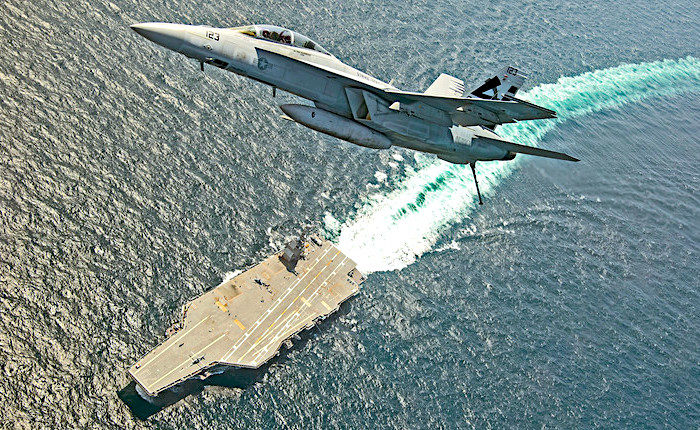
© Reuters/HandoutAn F/A-18F Super Hornet jet flies over the USS Gerald R. Ford, 2017
The US Navy's new $13 billion aircraft carrier was delivered with only two of its 11 elevators -vital to get munitions to its deck- operational.
For the Navy, it's the latest in a series of costly embarrassments.The USS
Gerald R. Ford is the first of the Navy's new Ford-class aircraft carriers, a hulking, 100,000-ton beast built to replace the aging fleet of Nimitz-class vessels. Already 23 percent over budget, it was delivered in 2017 but has yet to undergo so-called 'shock trials' to prove its combat readiness.
However, Rep. Elaine Luria (D-Virginia) told
Bloomberg this week that nine of the
Ford's weapons elevators are non-operational, and will require costly and time-consuming upgrades to get them working.
With the Ford's crew unable to move ordnance to deck, "the ship can't deploy," Luria -who serves on the House Armed Services Committee- said.
Senate Armed Services Chairman Jim Inhofe (R-Oklahoma) also hounded Vice Admiral Michael Gilday, President Donald Trump's nominee for Chief of Naval Operations, at his confirmation hearing on Wednesday.
"The ship was accepted by the Navy incomplete, nearly two years late, two-and-a-half billion dollars over budget, and 9 of 11 weapons elevators still don't work, with costs continuing to grow," Inhofe exclaimed, adding that the
Navy's lack of planning "ought to be criminal."
Immobile elevators are just one of a litany of problems facing the USS
Ford. A Pentagon
report published in 2017 revealed that
the carrier's catapults, arresting gear and radar systems are all of "poor or unknown reliability." The arresting gear - responsible for catching and rapidly slowing a landing jet - is
supposed to withstand 16,500 landings before failure. It can handle 19. According to the report, this gives the gear a 0.2 percent chance of surviving a day of sustained combat.
Furthermore,
the new ship is not compatible with the US Military's next-generation F-35 stealth fighter - itself plagued with cost overruns and reliability issues. In fact,
with the exception of the Nimitz-class USS Abraham Lincoln, not a single carrier in the US' 11-strong fleet can deploy with the F-35. Significant upgrades are necessary to ensure compatibility with the new jet, and even Ford-class carriers will need additional work after commissioning if they are to handle the F-35.
Why did the Navy accept a carrier that wouldn't work with its latest fighter jet? The simple answer is budgetary concerns. Spending caps imposed by Congress led the Navy to push the
Gerald R. Ford out quickly.
Issues like the faulty elevators and F-35 incompatibility could be fixed later, the thinking went. However, Rep. Luria's committee now wants to repeal these cost caps, and has included
language in their version of Congress' annual defense spending bill prohibiting the delivery of the next Ford-class carrier -the USS
John F. Kennedy- until the F-35 issue is resolved.
Scheduled for delivery in 2022, the John F. Kennedy currently faces the same problems as the Gerald R. Ford.Compounding the snafu is the fact that the Ford has not yet been subjected to 'shock trials.' This testing involves detonating underwater explosives near a fully-crewed ship to simulate the forces and stresses of combat.
If the trials were to find the Gerald R. Ford lacking, the Kennedy too would be scuppered, and the Navy would be left with two combat-unready ships and a $24 billion bill.Despite the ambiguity surrounding the Ford-class carriers' combat effectiveness and cost, one party in the story is likely pleased: manufacturer Huntington Ingalls Industries, a shipbuilding spinoff of defense giant Northrop Grumman. In addition to the
Ford and
Kennedy, the US Navy has awarded the firm a block
contract for the construction of two additional Ford-class carriers. Before the contract was awarded, more than 100 lawmakers wrote a letter to then-Defense Secretary Jim Mattis pushing for the two-carrier deal.
Reader Comments